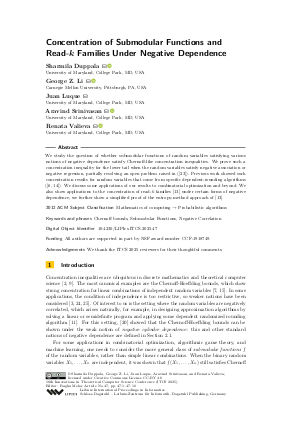LIPIcs.ITCS.2025.47.pdf
- Filesize: 0.67 MB
- 16 pages

 Creative Commons Attribution 4.0 International license
Creative Commons Attribution 4.0 International license

We study the question of whether submodular functions of random variables satisfying various notions of negative dependence satisfy Chernoff-like concentration inequalities. We prove such a concentration inequality for the lower tail when the random variables satisfy negative association or negative regression, partially resolving an open problem raised in ([Frederick Qiu and Sahil Singla, 2022]). Previous work showed such concentration results for random variables that come from specific dependent-rounding algorithms ([Chandra Chekuri et al., 2010; Nicholas J. A. Harvey and Neil Olver, 2014]). We discuss some applications of our results to combinatorial optimization and beyond. We also show applications to the concentration of read-k families [Dmitry Gavinsky et al., 2015] under certain forms of negative dependence; we further show a simplified proof of the entropy-method approach of [Dmitry Gavinsky et al., 2015].

Feedback for Dagstuhl Publishing